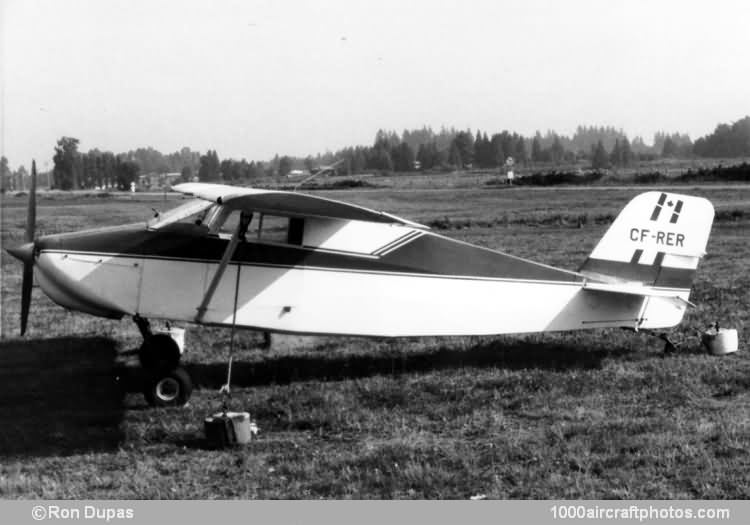12/29/2014. Remarks by Walter van Tilborg and Johan Visschedijk: "The Tailwind was an original design homebuilt two-seater of Steve Wittman and became very popular among amateur builders worldwide. Initially the first aircraft was developed for personal use by the designer and was initially known by Wittman as the Flying Carpet. It used the patented spring steel landing gear and first flew in January 1953 with an 85 hp Continental C85-12 engine. The aircraft initially flew with auxiliary endplates on the horizontal tail and was later re-engined with an 125 hp Lycoming O-290.
The designer also built a second very similar machine and a third aircraft, also built by Wittman, had a tricycle type landing gear. The 150 hp O-320 engine in the latter was later replaced by an 145 hp Continental O-300. The type attracted much attention and the Tailwind was soon offered for amateur construction as Model W-8 and later a license was obtained by AJEP in the UK.
W-8 Tailwind: The basic homebuilt version, which usually had a tail wheel landing gear, although aircraft were also completed with a tricycle type landing gear. Several hundreds were completed worldwide, powered by a Continental or Lycoming engine in the 85 to 150 hp range. At least one Tailwind was built with an 150 hp Porsche/VW 914 in the USA by Ivan Anderson. The Tailwind could be observed with a variety of vertical tails ranging from straight fins with rounded or flat top to swept fins.
W-8C Tailwind: This designation was used for a version that was very similar to the Model W-8, but featuring a slightly reduced wingspan.
W-9L/W-9 Tailwind: One aircraft, built by designer for personal use. It first flew in 1958 as W-9L, with a tricycle type landing gear. The aircraft had reduced wingspan and an 160 hp Lycoming IO-320-B1A engine. The same aircraft was later modified to Model W-9, with standard wings, an 145 hp Continental O-300-A and a tail wheel landing gear. It first flew in this form in 1965.
W-10 Tailwind: Successor of the initial W-8 Tailwind, with a redesigned wing without dihedral and with tapered wing tips. This model was suited for engines in the 145 to 180 hp range and was marketed for amateur construction by Aircraft Spruce & Specialty.
W-12 Tailwind: One experimental aircraft, built by the designer, with an 150 hp (de-rated from 285 hp) modified Oldsmobile V8 motorcar engine under a redesigned cowling. The W-12 was first flown in August 1974.
Tailwind WO: This was a one-off example built by Wittman and first flown in 1974. The aircraft initially had a modified Oldsmobile automotive V8 engine which was in 1978 replaced by a Oldsmobile F-85. The Tailwind WO was used by Wittman till around 1993 and in 19895 went to the EAA Museum collection.
Drag'N'Fly: Hybrid aircraft built in the USA by J.E. Tileston and first flown during 1963. This aircraft had a basic Tailwind fuselage, but the tricycle type landing gear was based on the Nesmith Cougar main landing gear and the aircraft featured foldable wings. It had an 125 hp Lycoming O-290-D engine.
Beer MWS-22: Modified W-8 Tailwind built around in the USA around 1992 by Arthur L. Beer. The aircraft (N83V) was powered by an 130 hp Subaru GJ-22 car engine, but later re-engined with an 118 hp Lycoming O-235.
AJEP W-8 Tailwind Series 1/ Series 2: In the UK a company named AJEP Developments Ltd, formed by Andrew John Elliot Perkins, acquired a license for the Wittman W-8 Tailwind and marketed an improved version for the domestic homebuilt market. The UK version had a new design swept vertical tail and was available as kit or as ready-to-fly (pre-assembled) aircraft with choice of tail wheel (Series 1) or tri-gear (Series 2). The first example was a Series 1 built by AJEP and this first flew on April 24, 1972, powered by a 90 hp AJEP PC-60 engine (modified from a Rolls-Royce/Continental GPU). This aircraft, registered G-AYDU, was in 1976 used for trials by BAe as a drone and was then fitted with a somewhat crude tri-gear, but after the completion of trials the aircraft reverted to the original tail wheel landing gear. A small number of Series 1 aircraft were completed in the UK with a Rolls-Royce/Continental O-200-A engine.
Marketing rights for the Tailwind were, in 1996, acquired by Aircraft Spruce & Specialties in the USA (plans and kits). Examples of the Tailwind were also built in countries such as Canada, UK, France, Australia, worldwide production is estimated at 350 to 400."
